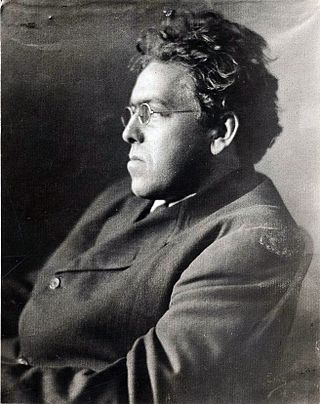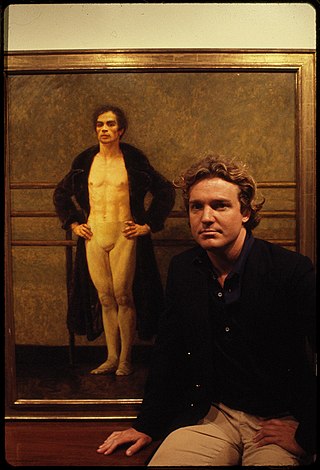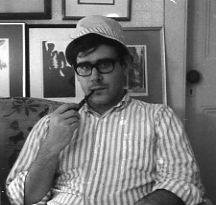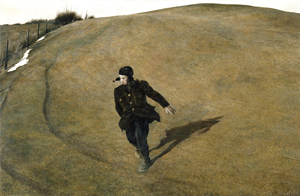
Peter Hurd was an American painter whose work is strongly associated with the people and landscapes of San Patricio, New Mexico, where he lived from the 1930s. He is equally acclaimed for his portraits and his western landscapes.
Henriette Wyeth Hurd was an American artist noted for her portraits and still life paintings. The eldest daughter of illustrator N.C. Wyeth, she studied painting with her father and brother Andrew Wyeth at their home and studio in Chadds Ford, Pennsylvania.

Andrew Newell Wyeth was an American visual artist, primarily a realist painter, working predominantly in a regionalist style. He believed he was also an abstractionist, portraying subjects in a new, meaningful way. The son of N. C. Wyeth and father of Jamie Wyeth, he was one of the best-known U.S. artists of the middle 20th century. James H. Duff explores the art and lives of the three men in An American Vision: Three Generations of Wyeth Art. Raised with an appreciation of nature, Wyeth took walks that fired his imagination. Henry David Thoreau, Robert Frost, and King Vidor's The Big Parade (1925) inspired him intellectually and artistically. Wyeth featured in a documentary The Metaphor in which he discussed Vidor's influence on the creation of his works of art, like Winter 1946 and Portrait of Ralph Kline. Wyeth was also inspired by Winslow Homer and Renaissance artists.

Newell Convers Wyeth, known as N. C. Wyeth, was an American painter and illustrator. He was a student of Howard Pyle and became one of America's most well-known illustrators. Wyeth created more than 3,000 paintings and illustrated 112 books — 25 of them for Scribner's, the Scribner Classics, which is the body of work for which he is best known. The first of these, Treasure Island, was one of his masterpieces and the proceeds paid for his studio. Wyeth was a realist painter at a time when the camera and photography began to compete with his craft. Sometimes seen as melodramatic, his illustrations were designed to be understood quickly. Wyeth, who was both a painter and an illustrator, understood the difference, and said in 1908, "Painting and illustration cannot be mixed—one cannot merge from one into the other."

James Browning Wyeth is an American realist painter, son of Andrew Wyeth, and grandson of N.C. Wyeth. He was raised in Chadds Ford Township, Pennsylvania, and is artistic heir to the Brandywine School tradition — painters who worked in the rural Brandywine River area of Delaware and Pennsylvania, portraying its people, animals, and landscape.
Robert Remsen Vickrey was a Massachusetts-based artist and author who specialized in the ancient medium of egg tempera. His paintings are surreal dreamlike visions of sunset shadows of bicycles, nuns in front of mural-painted brick walls, and children playing.
Bo Bartlett is an American Realist painter working in Columbus, Georgia and Wheaton Island, Maine.

The Greenville County Museum of Art (GCMA) is an art museum located in Greenville, South Carolina. Its collections focus mainly on American art, and its holdings include works by Andrew Wyeth,Jasper Johns, William Henry Johnson, Andy Warhol, Romare Bearden, Jacob Lawrence, Alma Thomas, Helen Turner, Charles Wilson Peale, Eric Fischl, Marylyn Dintenfass, and Leonardo Drew. Southern American and South Carolina-based artists, such as Elizabeth O'Neill Verner, are also represented.

Tenants Harbor Light, also known as Southern Island Light, is a lighthouse at the mouth of Tenants Harbor, St. George, Maine, United States. It appears in paintings by Andrew Wyeth and his son Jamie Wyeth, who have owned the lighthouse since 1978.
John Willard McCoy (1910–1989) was an American artist who painted landscapes, portraits, and still lifes. He was married to the composer Ann Wyeth, the daughter of painter N.C. Wyeth and sister of painter Andrew Wyeth.

The Helga Pictures are a series of more than 268 paintings and drawings of German model Helga Testorf created by American artist Andrew Wyeth between 1971 and 1985.
George Alexis Weymouth, better known as Frolic Weymouth, was an American artist, whip or stager, and conservationist. He served on the United States Commission of Fine Arts in the 1970s and was a member of the Du Pont family.
Carolyn Wyeth, daughter of N.C. Wyeth and sister of Andrew Wyeth, was a well-known artist in her own right. Her hometown was Chadds Ford, Pennsylvania. She worked and taught out of N. C. Wyeth House and Studio. Her nephew, Jamie Wyeth was one of her students.

The Kuerner Farm, also known as Ring Farm, is an historic farm which is located in Chadds Ford, Pennsylvania, United States. It is notable for its association with artist Andrew Wyeth, who created about one-third of his work, more than 1,000 paintings and drawings, on subjects he found there during a span of seventy-seven years.

Carroll Nathaniel Jones III was an artist in the style of American realism. Carroll grew up in New Providence, New Jersey, where his father, an illustrator for Life (magazine), was his first art teacher. He taught Carroll techniques of the Old Masters, who emphasized light, perspective, and composition. Carroll went to school in New York City (NYC) and enrolled in the Phoenix School of Design at age 17. He later attended Hartford Art School and became a commissioned portraitist for 10 years. After his work, Church Window was recognized in the New York Times, he moved away from portraits to recreate scenes that sparked memories of his childhood. Andrew Wyeth and Edward Hopper most influenced Jones. The Coe-Kerr Gallery of NYC and Whistler's Daughter Gallery of New Jersey represented Jones and contemporaries, Wyeth and Hopper. Malcolm Forbes, Frederick R. Koch, Stephen Sondheim, William Schuman, and Jean Shepherd held private collections. He exhibited at Newark Museum and Trenton Art Museum in New Jersey, and in universities, galleries and museums in seven states by his mid-thirties. His work is part of the permanent collections of Seton Hall University and Newark Museum. Art critic Marion Filler considered his work Magic realism, a quiet movement made famous in America beginning in the 1920s by Hopper, and related to Surrealism.

Winter Fields is a 1942 painting by the American artist Andrew Wyeth. It depicts a dead, frozen crow in a landscape with fields and distant farm buildings. The painting is hosted at the Whitney Museum of American Art, in New York.

Trodden Weed is a 1951 painting by the American artist Andrew Wyeth. It is a self-portrait, displaying the painter from his knees down, dressed in a pair of old, high leather boots.

Wind from the Sea is a 1947 painting by the American artist Andrew Wyeth. It depicts an inside view of an open attic window as the wind blows the thin and tattered curtains into the room.
American composer, pianist and painter Ann Wyeth McCoy was the youngest daughter of artist-illustrator N.C. Wyeth and the fourth of his five children. She was born in Chadds Ford, Pennsylvania.

Betsy James Wyeth was an author and art collector. She was also the business manager and archivist of her husband, artist Andrew Wyeth.













